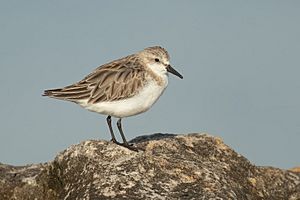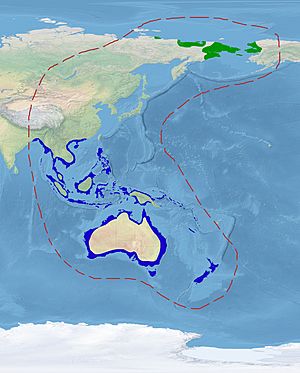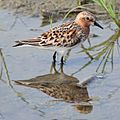Red-necked stint facts for kids
Quick facts for kids Red-necked stint |
|
|---|---|
 |
|
| A red-necked stint in its winter feathers. | |
| Conservation status | |
| Scientific classification | |
 |
|
| Where the red-necked stint lives. The green shows where they breed, and the blue shows where they spend winter. | |
| Synonyms | |
|
Erolia ruficollis |
The red-necked stint (say: STINT) is a tiny bird that loves to travel! It's a type of wader, which means it's a bird that walks in shallow water or mud to find food. Its scientific name is Calidris ruficollis.
The first part of its name, Calidris, comes from an Ancient Greek word. This word was used by a famous thinker named Aristotle to describe small grey birds that live near water. The second part, ruficollis, comes from Latin. Rufus means "red," and collum means "neck." So, its name literally means "red-necked water bird"!
Contents
About the Red-necked Stint
These birds are some of the smallest waders you'll ever see. They look a lot like another bird called the little stint. Red-necked stints are small, with a thin dark beak and dark legs. They also move very quickly!
They are about 13–17 cm (5.1–6.7 in) long, which is about the size of a small ruler. Their wings can spread 28–37 cm (11–15 in) wide. They weigh between 21–51 g (0.74–1.80 oz), which is lighter than a small candy bar!
When these birds are ready to breed, their chest turns a bright orange color. This orange area has dark marks below it. They also have a white "V" shape on their back. In winter, their feathers change, and they look a bit different. Young red-necked stints have more patterns on their backs. Their call sounds like a rough "stit."
Where Red-necked Stints Live and Travel
Red-necked stints are amazing travelers! They are strongly migratory birds. This means they fly very long distances between their breeding grounds and their winter homes.
They breed in the cold Arctic areas of eastern Eurasia. This includes places like Russia and parts of Asia. When winter comes, they fly south to warmer places. They spend the non-breeding season in Southeast Asia and Australasia. This can be as far south as Tasmania and New Zealand!
Sometimes, these birds get lost and fly to unusual places. They are rarely seen in western Europe, especially in Ireland. You might also spot them in western Alaska and sometimes in other parts of the Americas.
Red-necked Stint Behavior
Red-necked stints love to be with other birds. They are very social and often form large groups. They will even flock together with other small waders. You might see them with sharp-tailed sandpipers or curlew sandpipers in their winter homes.
Reproduction and Life Cycle
Red-necked stints build their nests on the ground in the tundra. Tundra is a cold, treeless plain found in Arctic regions. They breed from spring through the summer months.
What Red-necked Stints Eat
These birds look for food in wet grassy areas and soft mud. They mostly pick up their food by seeing it. In their winter homes, they search for food on muddy areas along the coast that are exposed at low tide. They also look along the muddy edges of freshwater lakes. Their main diet includes insects and other tiny creatures without backbones, called invertebrates.
- Calidris ruficollis in Field Guide: Birds of the World on Flickr
- species name is missing
See also
 In Spanish: Correlimos cuellirrojo para niños
In Spanish: Correlimos cuellirrojo para niños





